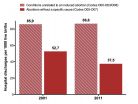(Press-News.org) Eribulin (trade name: Halaven) is approved for women with locally advanced or metastatic breast cancer in whom the disease has progressed despite prior drug therapy. The German Institute for Quality and Efficiency in Health Care (IQWiG) examined in a dossier assessment whether the drug offers an added benefit over the appropriate comparator therapy in these patient groups.
According to the findings, there are both positive and negative effects. There is proof of minor added benefit for one group of patients. For other groups, there are hints or indications of lesser benefit.
Second assessment of eribulin
IQWiG already presented a dossier assessment of eribulin in February 2012. The subsequent decision on the added benefit made by the Federal Joint Committee (G-BA) was limited until April 2014. In addition, the drug manufacturer meanwhile obtained approval for an expanded therapeutic indication: In March 2011 eribulin was only available for patients who have progressed further after at least two chemotherapeutic regimens. Since June 2014, however, the drug can already be used after one unsuccessful treatment attempt. Hence there were two reasons ─ independent from each other ─ for the reassessment of eribulin.
G-BA specified appropriate comparator therapies
When the G-BA specified the appropriate comparator therapy, it distinguished between several treatment situations: The first one refers to patients who are not eligible for further chemotherapy with a taxane or an anthracycline. In this situation, eribulin was to be compared with individual chemotherapy containing the drugs capecitabine or vinorelbine.
In patients for whom taxanes or anthracyclines are principally still an option, eribulin was to be compared with an individual chemotherapy containing a taxane or an anthracycline.
The decision for the adequate treatment should take into account whether the patients' cancer cells have highly increased levels of certain human epidermal growth factor receptors (HER) ("HER2/neu status positive"). If treatments targeting these growth receptors (anti-HER2/neu treatments) are an option for these patients, eribulin was to be compared with an anti-HER2/neu treatment. If this was not the case, the comparator therapies mentioned above applied to these patients.
Only data for patients with negative HER2/neu status evaluable
Two studies were available for the assessment, study 301 and EMBRACE. EMBRACE was already the basis of the first dossier assessment of eribulin. Both studies were open-label, randomized, controlled, multinational approval studies.
However, IQWiG could only include the data of the participants with HER2/neu status negative in the dossier assessment because it was unclear whether it was assessed if the patients with positive status were suitable for anti-HER2/neu treatment. And it was unknown how many of the patients with an unclear status were to be rated as positive and how many as negative. It has been the standard approach in Germany for several years, however, to determine the HER2/neu status of the primary tumour as a basis for decision for further treatment.
Advantage in survival, but disadvantage in severe side effects
Overall, IQWiG sees proof of an added benefit of eribulin with an extent that is to be rated as minor for patients who can no longer be treated with taxanes or anthracyclines and whose HER2/neu status is negative. These patients survived longer under eribulin treatment. But at the same time, severe side effects (CTCAE grade 3 and 4) were more common under eribulin.
Number of affected organs influences the result
There were both positive and negative effects of eribulin in patients who can still be treated with a taxane or an anthracycline and whose HER2/neu status is negative. However, the treatment result also depended on the number of organs where the tumour had already formed metastases.
Study discontinuation less common, severe side effects more common
On the one hand, patients in the eribulin group discontinued treatment less frequently due to adverse events, which resulted in a hint of lesser harm. On the other hand, severe adverse events (CTCAE grade 3 and 4) were more common, i.e. eribulin caused greater harm.
The dossier contained no data on the outcomes of symptoms (morbidity) and quality of life for women who can still be treated with a taxane or an anthracycline and whose HER2/neu status is negative.
Overall, IQWiG considers there to be a hint or an indication of lesser benefit in these patients.
G-BA decides on the extent of added benefit
The dossier assessment is part of the overall procedure for early benefit assessments according to the Act on the Reform of the Market for Medicinal Products (AMNOG) supervised by the G-BA. After publication of the manufacturer's dossier and IQWiG's assessment, the G-BA conducts a commenting procedure, which may provide further information and result in a change to the benefit assessment. The G‑BA then decides on the extent of the added benefit, thus completing the early benefit assessment.
An overview of the results of IQWiG's benefit assessment is given by a German-language executive summary. In addition, the Website gesundheitsinformation.de, published by IQWiG, provides easily understandable and brief German-language information on eribulin.
The G-BA website contains both general English-language information on benefit assessment pursuant to §35a Social Code Book (SGB) V and specific German-language information on the assessment of eribulin.
INFORMATION:
More English-language information will be available soon (Sections 2.1 to 2.6 of the dossier assessment as well as subsequently published health information on informedhealthonline.org )
If you would like to be informed when these documents are available, please send an e-mail to info@iqwig.de.
The current classification system for colorectal cancer, which is based on genetic expression profiles, cannot be used to predict drug responses to FOLFIRI. This is the conclusion reached by a team from the Spanish National Cancer Research Centre (CNIO), formed by members from the Gastrointestinal Cancer Clinical Research Unit and the Structural Computational Biology Group. The study, published this week in the journal Nature Medicine, will assist oncologists in making better-informed decisions regarding how to treat their colorectal cancer patients in the clinic.
Conclusions ...
Published in Nature Biotechnology, the study showed that specially engineered lipid (fat) bodies, called liposomes, can be used to prevent bacterial toxins from killing human cells.
This could prevent unnecessary deaths from diseases such as pneumonia and sepsis. The treatment is a valuable alternative to current medications, particularly for infections that have become resistant to antibiotics.
The bacterial toxins, produced by major human pathogens such as Streptococcus pneumonia, Streptococcus pyogenes and Methicillin Resistant Staphlycoccus aureus (MRSA) were ...
During hibernation, dormice enter into 'torpor' to save energy and water. In this state, the dormice become inactive and show a marked decrease in their metabolic rate, causing their body temperature to reduce.
Torpor was then found to be a strategy used when food availability was limited. The researchers compared two groups of juveniles born late in the season - one able to feed freely and the other intermittently fasted on alternate days. The fasted dormice showed considerably greater use of torpor, enabling them to maintain high growth rates and accumulate sufficient ...
Muscle-specific protein cofilin-2 controls the length of actin filaments in muscle cells.
Sliding of myosin and actin filaments past each other provides the force for muscle contraction. In contrast to most non-muscle cells, the actin filaments in muscle sarcomeres are of precise length and relatively stable. Defects in the organization of these actin filament arrays result in various heart and muscle disorders, such as myopathies.
The research group of professor Pekka Lappalainen at Institute of Biotechnology, University of Helsinki, has now revealed a new mechanism ...
Bethesda, MD -- After many generations, rats bred for their bad attitude behave differently from those selected for a calm demeanor around humans. Research published November 7 in the journal GENETICS identifies gene regions that contribute to differences between nasty and nice rats in their behavior and the activity of genes in the brain. These results may provide important clues as to which genes make tame animals like dogs behave so differently from their wild ancestors.
"Tameness is one trait that all domestic animals share. Whether it's pigs or cats or horses, domestication ...
This news release is available in Spanish.
Legal restriction of abortion has a negative connotation since the idea of women resorting to illegal abortion -risking their own lives- is strongly rooted in the public opinion worldwide. However, a series of independently peer-reviewed articles, challenge this notion in some countries. The latest data in this subject have been discussed by the Chilean epidemiologist Elard Koch, Director of Research of the MELISA Institute, in the current issue of the official journal of the Chilean Society of Obstetrics and Gynecology. ...
SALT LAKE CITY, Utah, Nov. 7, 2014 - Myriad Genetics, Inc. (Nasdaq: MYGN) today presented results from a prospective clinical utility study of its Myriad myPath Melanoma test at the 2014 American Society of Dermatopathology (ASDP) annual meeting in Chicago, Ill. Myriad myPath Melanoma is a genetic test that differentiates malignant melanoma from benign skin lesions across all major melanoma subtypes. Key findings of this clinical utility study included a 43 percent reduction in indeterminate diagnoses and a 49 percent change in physicians' treatment recommendations for ...
Scientists from the RIKEN BioResource Center in Tsukuba, Japan, have discovered that a single mutation in the beta-catenin gene, which codes a protein known to be deeply involved in a number of developmental and homeostatic processes, can lead to infertility not through a disruption of the production of egg or sperm cells, but rather by leading to abnormalities in the morphology of the sexual organs, making natural reproduction impossible.
Beta-catenin is an essential protein in the Wnt/beta-catenin signaling pathway, which has been shown in mice to be involved in the ...
It arises from what scientists previously described as "junk DNA" or "the dark matter of the genome," but this gene is definitely not junk.
The gene GAS5 acts as a brake on steroid hormone receptors, making it a key player in diseases such as hormone-sensitive prostate and breast cancer.
Unlike many genes scientists are familiar with, GAS5 does not encode a protein. It gets transcribed into RNA, like other genes, but with GAS5 the RNA is what's important, not the protein. The RNA accumulates in cells subjected to stress and soaks up steroid hormone receptors, preventing ...
The present-day extinct ancestors of turtles had a flexible ribcage and breathed, like us, by alternately expanding and contracting the lungs and thorax. The development of a solid shell on the back and belly, however, rendered this kind of respiratory process impossible. Today's turtles breathe with the aid of a muscle sling attached to the shell, which contracts and relaxes to aerate the lungs. An international team of researchers from North American, African and European institutes and museums have now discovered the origin of this muscle sling: in Eunotosaurus africanus, ...

